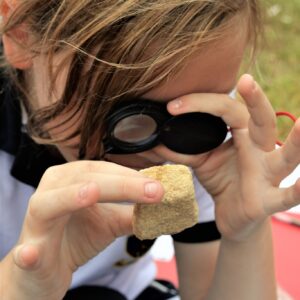
Year 4 Science and Technology Excursion to Long Reef
The Year 4 Science and Technology excursion to Long Reef on the Northern Beaches was a great day! The girls were challenged to be field investigators, looking for evidence of weathering, erosion and deposition in a coastal environment. To frame their learning, the inquiry questions were posed: How does the Earth’s surface change over time? How do natural processes and human actions change the Earth’s surface over time?
The day began with an area description of the Long Reef headland and rock platform. We learned that it was formed over 240 million years ago and is mostly made up of Bald Hill claystone. The girls handled some Hawkesbury sandstone, a type of sedimentary rock, and by grinding two samples together, they discovered one way in which the sand on Long Reef beach is formed.
They described its characteristics, examined various grain sizes using a hand lens and categorised its coarseness using the scale pictured below.

Down on the beach, the girls investigated erosion of the sand dunes. Working collaboratively, each group used an anemometer to measure wind speed at the front of the dune, then moved to the back of the sand dune to compare the results in kilometres per hour. After collecting several readings, they shared their findings and discovered the wind was at least four times more powerful on the side facing the sea! It was also evident that the waves had also caused part of the mounds to suddenly fall away. They noticed the critical role plants play in preserving the sand dunes and using a plant guide, they discovered species of Pennywort, Pigface and Coast Wattle, which is a shrub with leaves between 5 to 10 centimetres in length.
Walking around the headland, exploration of weathering, erosion and deposition continued. Practical experience included using a tape measure to measure the size of the boulders and a laser range finder to estimate the height of the cliffs in metres. The girls recorded their data in tables and analysed the results to consider how the many boulders varied due to erosion caused by gravity, abrasion, rain and wind.
Boasting a rich history, we also discovered a coast shell midden on the headland. As the shells become exposed due to erosion, it provided evidence of past meals eaten by Aboriginal people. We even found a Port Jackson shark egg as we studied the rock pools!
In the final challenge of the day, the students engaged in building a sandcastle and using loose parts found on the beach to protect it from erosion.
Whilst we ran out of time to test the robustness of the sandcastles, the girls will have an opportunity to put their scientific knowledge and skills to the test back in the classroom. Thinking deeply about the extensive erosion caused by the heavy rains in 2022, the students are excited about producing a design solution to protect Long Reef. They will generate and communicate ideas, collaborate and refine plans before constructing a model to solve a real-world problem using a range of recycled materials brought in from home.

Gabriela Grocott
Year 4 Science and Technology Teacher

















